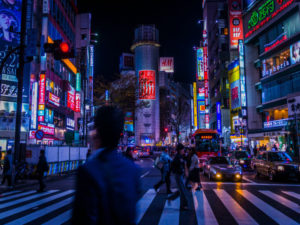A new decade marks a new era of technology and innovation.
Films throughout the ages have tried to predict what the future will look like, and some have been accurate. Most tend to overemphasize flying cars and laser guns.
It’s hard to predict what the forthcoming years have in store, but it’s thrilling to try and guess. Will our present reality and the wonders of movie magic ever completely merge?
Until the answers become clear, here are a few things movies have predicted and their real-life equivalents.
Modern Transportation
You’ll find plenty of flying police cars and recreational vehicles in “Blade Runner,” but today’s commuters tend to favor ridesharing, buses and subways. Arguably, the most advanced transportation that has seen widespread integration are bullet trains. These speedy locomotives are a staple in Japan, but they may become more commonplace in other countries soon enough.
Developing technologies will build on existing methods—such as driving, walking or riding—to create new ones. You can find autonomous cars in an increasing number of cities, and Toyota aims to create a nearly driverless municipality. All vehicles would be self-driving and connected to a city-wide operating system.
Developers haven’t created airborne automobiles yet, but don’t be surprised if they’re on the way.
Artificial Intelligence

The “Terminator” series, “I, Robot,” and the Netflix Original “I Am Mother” all warn of a future where robots rule the Earth. Gone are the days of autonomy and fundamental rights. People follow the beck and call of metal machines. While an android apocalypse is unlikely to happen any time soon, the robotics field has experienced major growth in recent years.
Sophia the Robot gained internet fame and achieved meme status, while canine-like police droids have stirred up apprehension among many. The next breakthrough in robotics appears to be xenobots, which consist of frog stem cells and can self-heal. Nature continues to merge with machinery in surprising ways with the creation of melanin-based electronics.
Sky-High Buildings
Impossibly high skyscrapers are a moviemaker’s go-to element for futuristic films. These structures aren’t too different from the massive buildings in cities across the world now. However, many of those in movies feature details people can only dream of, such as freeways connecting buildings and teleportation portals instead of doors.
Modern architects have taken plenty of design cues from sci-fi films, constructing buildings with sleek lines and layers of reflective metal. However, it’ll be a while before you can take a taxi from your office straight to your apartment complex—all in midair.
One thing you can look forward to, though, is green roofing. More companies want sustainable buildings, and investing in greenery is the current trajectory. This trend is far from the smoggy, smoky skylines we’ve seen on the big screen, but something a little more utopian.
Interplanetary Cities
People are looking toward Mars as a possible savior in the fight to stop climate change. “Guardians of the Galaxy” and the iconic “Star Wars” series depict life on other planets as an everyday thing. Space travel, in reality, hasn’t gotten much farther than the moon. If it’s possible to build human cities on other planets, there is tremendous work ahead to realize this goal.
Jason Dunn, the co-founder of 3D printing company Made in Space, believes that outer space will someday support oil platforms, industrial factories and more. His company has a partnership with Axiom Space, which produces space stations that could hold manufacturing equipment for space-based construction.
High-Tech Solutions
From “The Fifth Element” to “Lucy,” every futuristic movie you see features highly advanced technology. After all, how many people today can say they’ve downloaded their brain to a USB? “The Hunger Games” trilogy may not be your first choice for hard science fiction, but the Capitol’s genetic engineering speaks to a future way ahead of modern-day applications.
Scientists are catching up, though. Experts have already used controversial gene-editing techniques to create “designer babies” and crossbreed animals. Some high-tech companies have produced devices that can induce lucid dreaming by sending currents into the brain. This brave new world will begin to witness inventions of new technological magnitudes.
Peering Into a New Tomorrow
The future stretches far in front of you. No one can tell whether it’ll be like a sci-fi utopia or an apocalyptic nightmare, but everyone hopes for the former.
One thing is sure—movies help expand your imagination and let you dream of a tomorrow that’s very different from today.